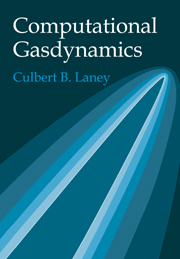Book contents
- Frontmatter
- Contents
- Preface
- Chapter 1 Introduction
- Part I Gasdynamics Review
- Part II Computational Review
- Chapter 6 Numerical Error
- Chapter 7 Orthogonal Functions
- Chapter 8 Interpolation
- Chapter 9 Piecewise-Polynomial Reconstruction
- Chapter 10 Numerical Calculus
- Part III Basic Principles of Computational Gasdynamics
- Part IV Basic Methods of Computational Gasdynamics
- Part V Advanced Methods of Computational Gasdynamics
- Index
Chapter 9 - Piecewise-Polynomial Reconstruction
Published online by Cambridge University Press: 07 December 2009
- Frontmatter
- Contents
- Preface
- Chapter 1 Introduction
- Part I Gasdynamics Review
- Part II Computational Review
- Chapter 6 Numerical Error
- Chapter 7 Orthogonal Functions
- Chapter 8 Interpolation
- Chapter 9 Piecewise-Polynomial Reconstruction
- Chapter 10 Numerical Calculus
- Part III Basic Principles of Computational Gasdynamics
- Part IV Basic Methods of Computational Gasdynamics
- Part V Advanced Methods of Computational Gasdynamics
- Index
Summary
Introduction
The last two chapters dramatically demonstrate the folly in attempting to represent a discontinuous function by a single polynomial. In the best case, with the entire true function available, the single polynomial representation will suffer from narrow width but large-amplitude Gibbs oscillations near the jump discontinuities, at least when minimizing the error in ordinary norms, as seen in Chapter 7. In more typical cases, with only limited information about the true function available or, more specifically, with only samples of the function available, the single polynomial will suffer from the Runge phenomenon, a relatively severe form of spurious oscillation that can increase rapidly as the number of samples increases, as seen in Chapter 8.
To overcome the problems associated with single-polynomial reconstructions, this chapter will consider piecewise-polynomial reconstructions, which were introduced earlier in Section 6.3, especially in Example 6.8. In piecewise-polynomial reconstructions, instead of representing the entire function by a single polynomial, we represent different local regions or cells by different polynomials. Figure 9.1 illustrates a typical piecewise-polynomial representation. By using separate and independent polynomials for each cell, only the cells containing jump discontinuities need suffer from large spurious oscillations, rather than the entire representation. Furthermore, piecewise-polynomial representations naturally allow jump discontinuities: the simplest reconstructions allow jump discontinuities only at cell edges, whereas the subcell resolution techniques discussed in Section 9.4 allow jump discontinuities to occur anywhere, including the insides of cells. Of course, piecewise-polynomial reconstructions cost more to build and evaluate and require more storage space than a single polynomial reconstruction; however, for discontinuous functions, the accuracy improvements easily justify the additional costs.
- Type
- Chapter
- Information
- Computational Gasdynamics , pp. 150 - 171Publisher: Cambridge University PressPrint publication year: 1998



